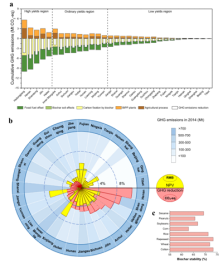On March 16, Prof. Yang Qing together with his team members have made important progress in negative-carbon technology and concept of low-carbon development planning, which then was released on Nature Communications, as entitled Prospective contributions of biomass pyrolysis to China's 2050 carbon reduction and renewable energy goals. The study explores the contributions of biomass-based carbon-negative technology to China's achievement of both carbon neutrality and renewable energy goals (as shown in Figure 1).
The widespread application of NETs is considered essential to achieve the central objective of the Paris Agreement, that is, effectively limiting global temperature increase to be below 2 or 1.5 degrees Celsius. Two NETs that mainly rely on photosynthesis have been attracted much attention due to their ability to provide energy and huge potential: (1) bioenergy technology (BECCS) coupled with carbon capture and storage (CCS), (2) biochar production and storage. Considering that it may take many years for BECCS to get mature, the study focuses on the negative-carbon technology of biochar production, which is easier to implement in China: biomass intermediate pyrolysis poly-generation (BIPP). This technology can produce combustible gas and electricity economically while generating biochar. The study results show that if a national carbon market is established in China, the BIPP system can be profitable without subsidies. If it is applied immediately nationwide, carbon emissions per unit of GDP in 2030 can be reduced by 2-61% compared to that of 2005, together with significant reduction of the emission of air pollutants. After 2030, the coupled utilization and coordinated development of BECCS and Biochar production may be applied, resulting in a cumulative reduction of greenhouse gas emissions as high as 8,620 million tons of carbon dioxide by 2050, with a contribution rate of 13%-31% to the global BECCS greenhouse gas emission reduction target. The coupled application of BECCS and Biochar will achieve a reduction goal of nearly 4555 million tons compared with the the application of BECCS alone by 2050. The study mainly elaborates on the important impact of China's deployment of NETs on achieving national and global greenhouse gas emission reduction targets. This work was supported by the National Natural Science Foundation of China, the State Key Laboratory of Coal Combustion (SKLCC) Fund and the Double First-Class Research Fund of the HUST China-Europe Institute for Clean and Renewable Energy (ICARE).

Figure 1 The spatial distribution of greenhouse gas emission reduction in China's BIPP system and its economic feasibility for different provinces
The article was published by Prof. Yang Qing and his doctoral student Zhou Hewen as the first authors, and Prof. Yang Qing, Prof. Chen Hanping from the SKLCC, and Prof. M.B. McElroy from Harvard School of Engineering as the corresponding authors, with HUST as its first unit In addition, other scholars and teams like teams from the US Harvard University, the University of Perugia in Italy, the UK University of Edinburgh, Utah State University in the US, Tsinghua University, and Peking University, also got involved in the study. As of now, Prof. Yang Qing has published more than 40 SCI papers as the first /corresponding author on domestic and foreign influential journals, including more than 30 articles on Q1 journals (the top 25% in ranking), more than 20 articles as indexed by SSCI, 13 articles with an impact factor greater than 10, and 3 highly cited articles of ESI, and 1 hot article, with H index of 28, and 2165 citations; he has served as review expert to IPCC report, reviewer to internationally renowned journals including Joule, Renewable and Sustainable Energy Reviews, Applied Energy, Energy, Journal of Cleaner Production and Energy & Fuels, etc. He is also a member of the International Association for Energy Economics (IAEE) and the International Association for System Dynamics (ISDA).
Paper Link: https://www.nature.com/articles/s41467-021-21868-z




